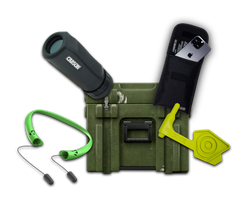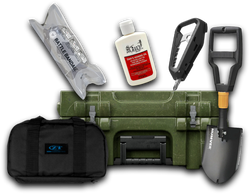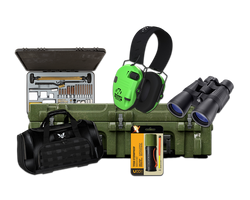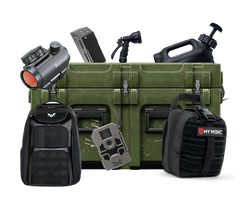How Long Is a Crowbar? Understanding the Key Dimensions and Uses
Table of Contents
- Introduction
- The Anatomy of a Crowbar
- How Long Is a Crowbar? Common Lengths Explained
- Choosing the Right Crowbar for Your Needs
- Practical Applications of a Crowbar in Tactical Situations
- Why Crate Club Recommends a Crowbar
- Conclusion
Introduction
Imagine you're faced with a stubborn door that just won't budge, or perhaps you need to pry open a crate filled with valuable supplies. What tool comes to mind? For many, the answer is a crowbar. This versatile tool has been a staple in both construction and survival scenarios for decades. But beyond its practical applications, there's a prevalent curiosity about its dimensions—specifically, how long is a crowbar?
The typical crowbar length varies widely, with options ranging from compact models to longer variants designed for heavy-duty tasks. This variability can be influenced by the specific function it serves, the manufacturer, or even the cultural context in which it is used. Understanding the dimensions of crowbars is crucial for selecting the right tool for your needs, whether you're a DIY enthusiast, a tactical gear aficionado, or prepping for emergency situations.
In this blog post, we will delve deeply into the various lengths of crowbars, their construction, applications, and why a crowbar is an essential tool in any tactical or survival kit. By the end of this article, you will not only know the average lengths of crowbars but also how to choose the right one based on your specific needs.
The Anatomy of a Crowbar
Before we dive into the lengths of crowbars, it’s important to understand their anatomy and how their design influences functionality. A crowbar typically comprises three main parts:
- The Handle: The handle is designed for gripping and controlling the tool. Its length can affect leverage and comfort during use.
- The Shank: The long, straight portion that provides the necessary leverage for prying or lifting objects. This is the part of the crowbar that varies in length.
- The Claw or Tip: This end is often bent or curved, allowing it to pry open doors, lift nails, or break apart objects. The design of the claw can also impact the tool's effectiveness in various applications.
Key Materials Used in Crowbar Construction
Crowbars are usually made from high-strength steel to ensure durability and resistance to bending or breaking under pressure. Some brands may offer crowbars with additional features such as:
- Powder Coating: This finish helps prevent rust and enhances grip.
- Rubberized Handles: For better grip and comfort during extended use.
Understanding the materials and construction techniques can help you choose a crowbar that fits your intended use.
How Long Is a Crowbar? Common Lengths Explained
Crowbars come in a variety of lengths, each suited for different tasks. Here's a breakdown of the most common crowbar lengths and their typical applications:
1. 24-Inch Crowbars
- Average Length: 24 inches (61 cm)
- Typical Use: These shorter crowbars are ideal for light-duty tasks such as removing small nails or prying open boxes. Their compact size makes them easy to handle and store, making them a favorite for DIY enthusiasts and home improvement projects.
2. 30-Inch Crowbars
- Average Length: 30 inches (76 cm)
- Typical Use: A very popular size, the 30-inch crowbar strikes a balance between leverage and portability. It’s excellent for general-purpose tasks like prying open doors or crates, and it can be used effectively in emergency situations.
3. 36-Inch Crowbars
- Average Length: 36 inches (91 cm)
- Typical Use: These crowbars offer enhanced leverage for heavier tasks. They are often employed in construction and demolition settings, where extra force is required to remove stubborn materials or break apart structures.
4. 48-Inch Crowbars and Longer
- Average Length: 48 inches (122 cm) and above
- Typical Use: For heavy-duty applications, longer crowbars provide significant leverage and power. They are commonly used in professional settings, especially in construction, demolition, and rescue operations where maximum force is required.
Crowbar Length Variability
While the lengths mentioned are common, it's essential to note that different manufacturers may produce crowbars of varying specifications. Additionally, custom crowbars can also be made, especially for specialized applications, leading to an even wider array of lengths available on the market.
Choosing the Right Crowbar for Your Needs
When it comes to selecting a crowbar, consider the following factors:
1. Purpose of Use
Determine what tasks you’ll primarily be using the crowbar for. If it's for light household chores, a shorter crowbar will suffice. However, for construction or emergency situations, investing in a longer, more robust crowbar is advisable.
2. Storage and Portability
If you plan to carry the crowbar in a vehicle or store it in a compact space, choose a shorter model. Long crowbars can be more cumbersome and may not fit in standard storage compartments.
3. Weight and Material
Consider the weight of the crowbar, especially if you need to carry it for extended periods. High-strength steel is generally heavier but provides superior durability. Conversely, lighter materials may be easier to handle but could sacrifice strength.
4. Grip Comfort
Look for crowbars with rubberized or ergonomic handles to ensure comfort during use. This is especially important if you anticipate using it for extended periods.
Practical Applications of a Crowbar in Tactical Situations
A crowbar is not just a tool for construction; it holds immense value in tactical and survival scenarios. Here are some practical applications:
1. Emergency Situations
In emergency situations, such as natural disasters, a crowbar can be invaluable for:
- Debris Removal: Clearing fallen objects or materials to create safe passages.
- Gaining Entry: Prying open doors or windows that are obstructed or locked.
2. Survival Scenarios
In survival situations, having a crowbar can be a game-changer:
- Resource Acquisition: A crowbar can help pry open crates or containers to access food, tools, or other essential supplies.
- Self-Defense: In a pinch, a crowbar can serve as an effective improvised weapon against threats.
3. Tactical Gear
For those in the tactical community, a crowbar is an essential part of a preparedness kit. It can be used for:
- Vehicle Extraction: Prying open vehicle doors to rescue trapped individuals.
- Field Repairs: Assisting in makeshift repairs to equipment or shelter.
Why Crate Club Recommends a Crowbar
At Crate Club, we understand the importance of having the right tools at your disposal. Our curated subscription service offers tactical gear that is meticulously selected for quality and reliability. A crowbar is one of those essential tools that can make a significant difference in both everyday situations and emergencies.
Crate Club Subscription Services
By subscribing to one of our tiers, you ensure that you receive the best mix of survival and tactical gear delivered to your door each month. Whether you choose the Lieutenant tier for casual use or the General tier for professional-grade tools, Crate Club has you covered.
Explore our subscription options here: Crate Club Subscription Services.
Crate Club Shop
If you want to explore a range of tactical gear, including crowbars, check out our shop for quality products that meet high standards. Equip yourself with the tools you need: Crate Club Shop.
Conclusion
Understanding how long a crowbar is, along with its various applications, is essential for anyone looking to enhance their toolkit—whether for home improvement, survival, or tactical purposes. With lengths ranging from 24 inches to over 48 inches, there’s a crowbar for every need and situation.
Incorporating a crowbar into your gear collection is a strategic choice that can empower you to tackle various challenges, from simple household tasks to critical rescue operations. As you consider adding a crowbar to your arsenal, remember to evaluate your specific needs and select the right length and material to ensure optimal performance.
With the right tools, preparedness becomes second nature. Join the community of tactical enthusiasts and be ready for anything.
FAQ Section
Q: What is the most common length of a crowbar?
A: The most common lengths of crowbars are 24 inches and 30 inches, which are suitable for general use and light tasks.
Q: Can a crowbar be used as a weapon?
A: Yes, a crowbar can be used as an improvised weapon in self-defense situations, thanks to its sturdy construction and effective leverage.
Q: Is there a specific crowbar recommended for emergency situations?
A: For emergency situations, a longer crowbar (36 inches or more) is often recommended because it provides better leverage and can handle heavier tasks.
Q: How do I maintain my crowbar?
A: To maintain a crowbar, clean it regularly to remove dirt and debris, and check for any signs of rust or damage. Applying a protective coating can also enhance durability.
Q: Where can I purchase a high-quality crowbar?
A: High-quality crowbars can be purchased from hardware stores or specialty shops. You can also explore options available through the Crate Club Shop.
Equip yourself with the right tools for the challenges ahead, and remember that being prepared is the key to confidence in any situation!
Share this article



